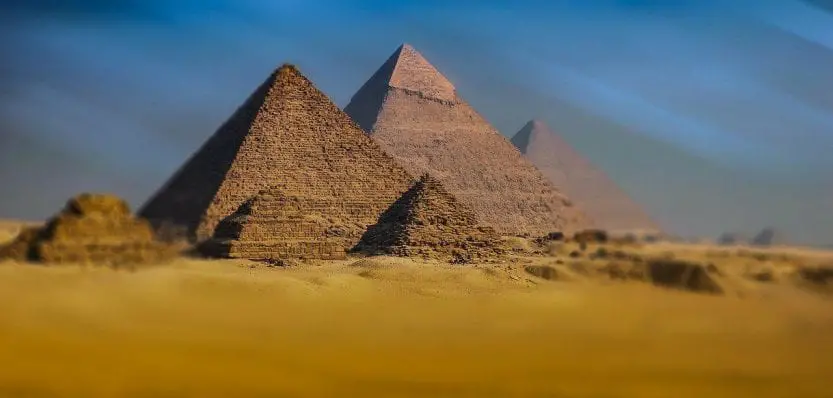Ancient Egypt is known to the outside world as the land of exceptional architecture and a sensational culture. It is replete with accounts of Gods, and their firm belief in after life. One of the main reasons for their popularity is because most of Ancient Egypt’s artefacts, including the mummified bodies of Pharaohs, is still very much intact today.
From what we know of their systems of expression, it is evident that context is everything. All art works are symbolic with reference to the external world. But more importantly, all art works are part of a symbolic system within themselves. Hieroglyphics, which were the predominantly used system of writing, could not be interpreted without identifying the pattern first. The meanings of letters changed depending on the direction in which they were facing in that specific text. The same applied to paintings and colors.
Color symbolism in Ancient Egyptian paintings
Each element of a painting represented more than what met the eye. And yet, these symbols changed meanings when the context changed. The symbolic meaning of colors changed depending on the paintings they featured in. In paintings of ordinary people, they simply meant the normal way of life. On Gods, colors had many layers of meanings.
The ancient Egyptians interpreted everything in nature as the work of a God. They had specific Gods for every event and every element in nature. Even natural disasters such as floods had a God behind it. The Nile river had a reputation for flooding every year and this phenomenon was considered the deed of the God Hapi. Paintings depict Hapi with blue color which represented Nile. Paintings from ancient Egypt are replete with blue symbolism.
Evidently, color was an important aspect of Egyptian culture. They were not simply tools of self expression. Colors had a language of their own. In the records that remain of the ancient Egyptian culture, there are references to four colors; black, white, red and green. However, the paintings include six colors, including blue and yellow. The word for green was also used to refer to blue and sometimes the word for red referred to yellow. This is not an uncommon phenomenon in ancient cultures. Before we developed a sophisticated color palette with specific names for different shades of colors, several cultures combined more than one color under one color term. A very well known example is the Japanese ‘ao’ which refers to both blue and green. Japanese traffic signals often have blue color in place of green.
Each color represented a quality of whoever was painted in it. People depicted in the paintings had their whole history and personalities represented through colors.
The colorful Egyptian Gods
Although the Gods are always associated with natural elements they influence, the paintings rarely include such details. Instead, they let the colors do the speaking. Ra, the God who created world and the other Gods is often associated with the Sun. The skies are believed to be his abode. These features are represented with red and blue colors on his skin. Red color represents the Sun and blue represents the skies. Additionally, the colors also reflect personal qualities. Red stands for power and creation. Blue indicates divinity and wisdom.
Similarly, Anubis, the God of death is depicted with black skin, referring to his dark intentions.
Hapi, the God of the Nile floods is depicted with full breasts and a belly. His skin is blue in color, with lines representing water ripples. Blue here represents bountifulness and fertility.
The God Osiris is known as the God of the underworld. The underworld here refers to both the mythical underworld of death and eternity, as well as the literal underground. These features are represented in his skin as black and green colors. Black depicts the darkness of death and green refers to the fertility of the soil.
Significance of blue in ancient Egypt
Whether Egyptians perceived the color blue is still debated. In several places, the color blue is often interchangeably used with yellow and green. However, there is no doubt that the color blue had a special significance in the ancient Egyptian culture. The following examples of blue symbolism are evidences to this.
The river Nile
The civilization developed around the river Nile and the society was mostly agrarian. Blue symbolism was used to depict the river Nile in paintings. Consequently, the color blue had connotations of benevolence and prosperity, qualities that were associated with the river Nile.
The association with Nile doesn’t stop there. One of the most significant records of the blue color is from paintings of the God Hapi. Hapi was the God responsible for flooding the rive Nile every year. He is depicted with blue skin, representing the purity and fertility of Nile. Additionally, the stone azure was believed to be the material of the Gods’ hair. Azue is a naturally occurring stone which is blue in color. Evidently, the color blue has a lot to do with Egyptian Gods. Blue, the color of Nile and the skies was also considered the color of life.
Thoth
The Egyptian God of wisdom was depicted in blue, or blue-green with elements of blue. Thoth is also the God of writing and magic. He is believed to have been either created from the lips of Ra or self-created. Thoth also has natural elements associated with his being, much like the other Gods. Baboons and phoenixes were depicted in relation to Thoth. They were painted blue to uphold this connection. Thoth’s spirit animal was the Ibis bird, which is also depicted in the ancient Egyptian art with vivid blue feathers. In relation with Thoth, blue symbolism was used to represent wisdom and spirituality. The phoenix bird, known for its ability tone reborn from its own ashes, extended meanings of rebirth and resilience to blue symbolism in the Egyptian culture.
Amon
Other Godly associations of the color blue includes the creator of the universe, Amon and the protector, Bes. Amon is often depicted with a blue face, which is assumed to have represented the power of creation. This is upheld by the tradition of painting the Pharaohs’ faces blue, as proud claims to their involvement in the process of creation. It is also believed in some versions of the mythology that Amon’s blue face was a reference to his title as the “hidden one”. The blue color is believed to represent invisibility in these versions. Amon’s invisibility is celebrated among people belonging to the marginalized communities. This quality is believed to contribute to his impartial nature. As a result, blue symbolism includes tones of the creator and efficient leadership.
Bes
Bes, the God of sexuality and childbirth among other things, is also associated with the color blue. Bes is portrayed as a dwarf, with conspicuous ears and a huge head, along with wobbly legs.Despite his appearance in several depictions, he is often portrayed as a friend to children. It is often assumed that when children laugh for no reason, they are having fun with Bes. He is believed to be the protector of women and children, owing to his warrior skills. Pregnant women and infants are often seen wearing blue amulets to be assured of Bes’ protection.
History of the Egyptian Blue
Paintings that were recovered from ancient cultures were mostly painted using natural colors. They were limited in their options for color sources, since sophisticated extraction processes did not exist back then. All of the colors were extracted from fruits and flowers. This often created the idea that ancient people were unable to perceive colors other than the few primary colors.
Blue was one such color that is rarely found in ancient paintings, owing to the difficulty in locating a source. In ancient Egypt, for a long time, the only source of blue color was the azure stone which was very expensive. Only rich people could afford blue hues in their clothes and accessories, which gave the color blue a reputation for being the color of the rich.
Blue color came to be integrated into the mainstream Egyptian culture after they developed a cheaper technique for producing the blue color. This was achieved by mixing sand, copper and natron with some lime at a fixed temperature. This shade of blue came to be known as the “Egyptian blue”. Apart from being the first synthetic pigment in history, Egyptian blue has some very interesting aspects to it.
The most impressive feat in the whole process is that the ancient Egyptians succeeded in concocting a chemical substance with accurate temperature control, in a very limited setting. The accuracy of the process is evident in the fact that the shade remains impeccably same in paintings across centuries. Another interesting aspect of the Egyptian blue that excited historians is that, this shade of blue lights up under infrared light. This helps historians uncover the details of old paintings without having to scratch its surface.
The discovery of the Egyptian blue was a sensation across Egypt and beyond. Records of the use of Egyptian blue is seen across Mesopotamia and the Roman empire. The wide popularity of Egyptian blue turned out to be helpful later on. The recipe for Egyptian blue was lost during a certain period in history. Roman painters offered help with what they could figure about the ingredients of the color. However, it took a long time to figure out the temperature aspect of the process. This is yet again evidence of the ingenuity of the ancient Egyptians.




